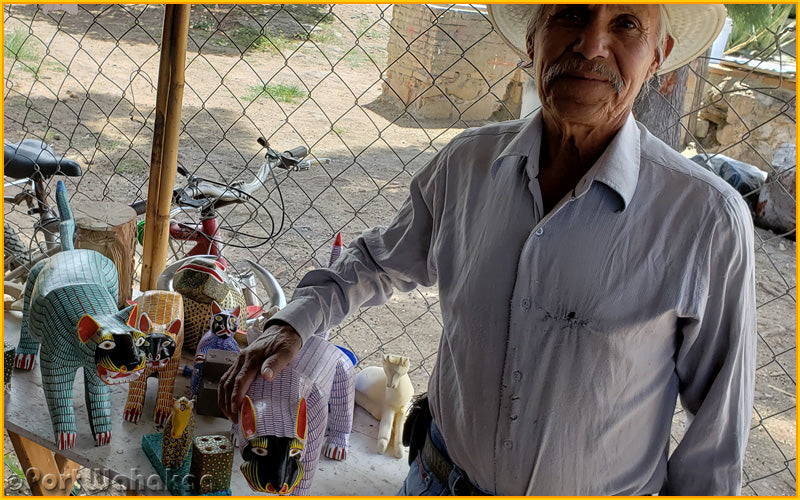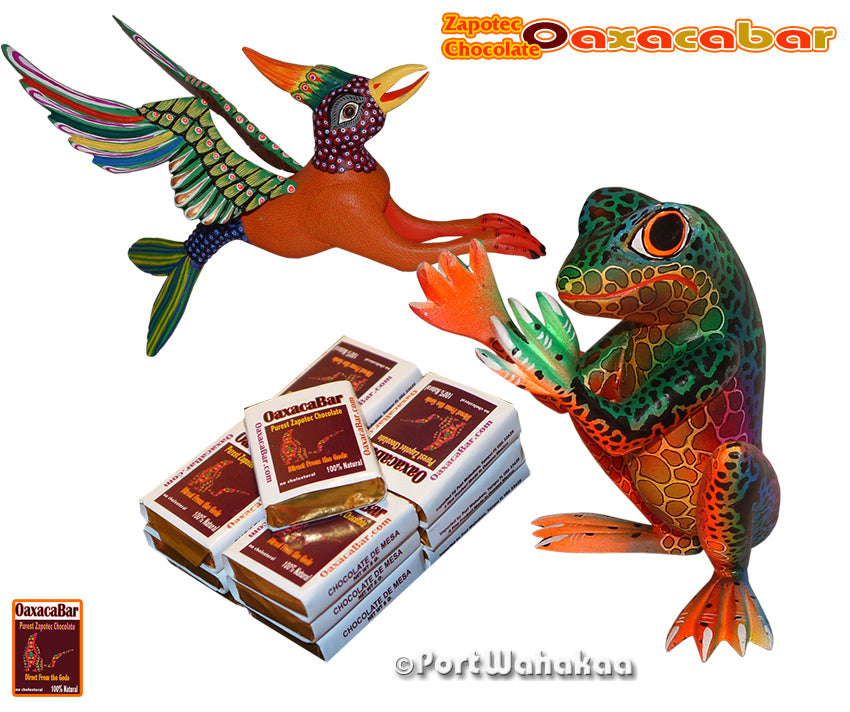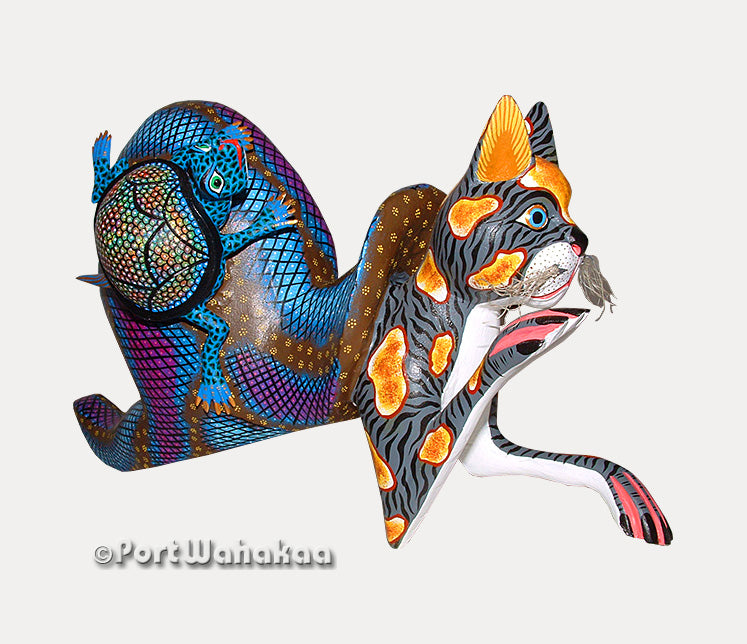News
Don Manuel Jimenez
Through serendipitous circumstances, we stumbled upon a magnificent homage to the master woodcarver of Arrazola and perhaps all of Oaxaca. Manuel Jimenez pioneered the art of figurine carving, pushing boundaries and introducing innovative techniques that inspired envy in his peers.
 Manuel Jimenez's unique talent lies in his mastery of carving wooden religious figurines for Cathedrals, the epitome of Oaxacan woodcarving tradition. His preference for Cedar over Copal due to its superior curing methods is evident in his later works.
Manuel Jimenez's unique talent lies in his mastery of carving wooden religious figurines for Cathedrals, the epitome of Oaxacan woodcarving tradition. His preference for Cedar over Copal due to its superior curing methods is evident in his later works.
 Don Manuel Jimenez While his figurines were technically impressive, it was his soft looking animals that caught the eyes of high end department stores like Neiman Marcus and luxury hotel gift shops. This transitioned into collections in folk art museums of La Jolla, Santa Fe, Los Angeles, Cleveland and Mexico City. Journals such as the Smithsonian Magazine and various Travel Magazines served as a successful conduit to the global audience.
Don Manuel Jimenez While his figurines were technically impressive, it was his soft looking animals that caught the eyes of high end department stores like Neiman Marcus and luxury hotel gift shops. This transitioned into collections in folk art museums of La Jolla, Santa Fe, Los Angeles, Cleveland and Mexico City. Journals such as the Smithsonian Magazine and various Travel Magazines served as a successful conduit to the global audience.

Manuel’s father was Mixtec and his mother from a separate village Zapotec. These two unique cultures possess their individuality, with the Zapotecs excelling in architecture and design, while the Mixtecs specialize in the art of weaving and painting. The fusion of Manuel's cultural ancestry may have been the catalyst for the full manifestation of the Oaxacan Woodcarving. As a child he was a herder and would study the animals in the fields under the ruins of Monte Alban. His creativity and imagination knew no bounds, as he sculpted clay figurines of the animals he observed. These figurines soon became his favorite toys, sparking imaginative games and inspiring inventive motifs that are still admired by artists today.

2024 April 8th Eclipse
The world is abuzz with a total eclipse arriving this April 8th. Many perspectives and speculation surrounding this incredible phenomenon that won't grace North America for another 70 years prompts contemplation. Years ago during our exploration of Tocuaro in remote rural Mexico, we discovered this captivating eclipsed themed figurine pictured above.
We were inside the studio of Master Maestro Artist Juan Horta famed mask maker. The walls were lined with the most imaginative magical masks of Tarascan myth and legend and we were dazzled. Close by in a hidden alcove painted in sky blue sat the unusual eclipse figurine by Gustavo Horta. The Hortas also work in copal wood, however, they add shiny purposeful lacquer as a practice and the painting style is entirely unique to Michoacan.

Masks by Juan Horta
Years later we found an intriguingly touching Tarascan story behind this beautiful eclipse themed sculpture and it goes like this.....

Figurine by Gustavo Horta
An old Purépecha/Tarascan legend tells of how for many eons the Sun and the Moon were married and were very happy living in the heavens. Their peaceful lives changed when Citalimina arrived in the sky, known to modern-day peoples as the planet Venus, the star of the morning and evening skies. When the young and very feminine Venus first came on the scene, everything changed.
One day, the Moon found the Sun talking to Venus. The Moon became jealous of her because Venus was a very beautiful star with a very long hair. The Moon accused the Sun of flirting with Venus and so the formerly peaceful and happy celestial duo began fighting and insulting one another. They fought physically, too, and as the Sun was stronger than poor Luna, it left her face full of bruises, which are the craters we can see on its surface from Earth if we observe it carefully.
The Moon decided to separate from the Sun and went very far, they did not talk anymore; that’s why one goes out during the day and the other at night. Naturally, this caused the formation of day and night on Earth. When the two heavenly bodies happen to come together in the skies, they once again become lovers who embrace at that time eclipses occur.
When the Moon and Sun separate again, the Moon begins to cry a lot for the sadness it gives her, and each tear that falls to the Earth turns into drops of silver, which the Purépecha women collect to make beautiful earrings that are shaped like a half moon, with silver tears hanging from them.

Tarascan Pyramid Complex Tzintzuntzan Michoacan, Mexico 2004

April 8th Eclipse Wimberley Texas 2024
Entrance to the Underworld
Marciano versus the Alebrije
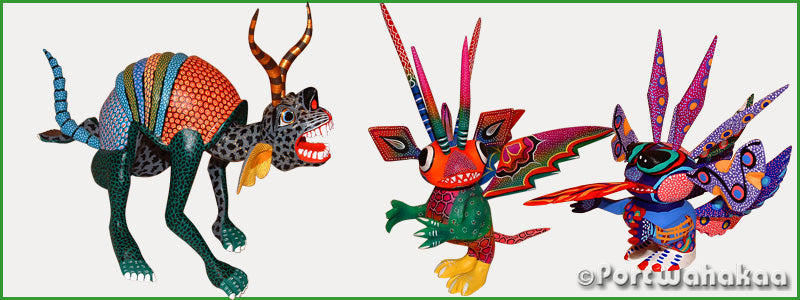
Once upon a woodcarving in the village of San Martin a devil and a porcupine decided to have a child and the result was the Marciano. These eye catching creatures have many appendages like wings, fins, ears, horns, and tails. During their heyday of 1980’s and 1990’s a host of different artists did their own variations, riffing and evolving off of one another. Impressive pieces from the Mendez family and Angeles family are some of Port Wahakaa’s earliest examples from the dawn of digital cameras. The Mendez Marcianos were over a foot tall and the Angeles aliens were half that but had the cutest expressive eyes.
At some point in time the Sosa family (Carmelo and Luis) once known for tyrannical dragons created the iconic standard still seen today. While they are now assumed to be Alebrijes they are rooted to the Marciano space creature ‘Martian’. Ironically, If you were to enter the term ‘alebrije’ into a search engine in the 1990’s you would see Spanish websites talking about the movie Star Wars and the images would be of the Mos Eisley cantina. 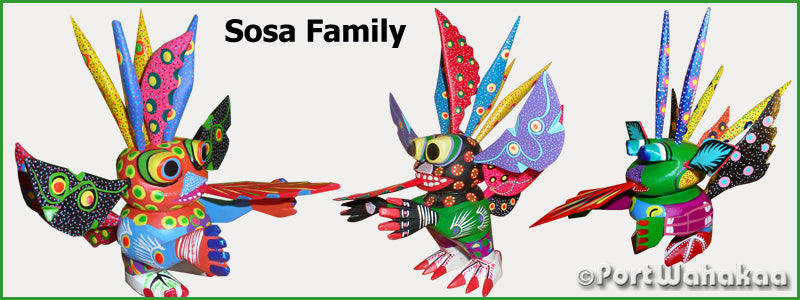
Marciano’s have been said to ward off evil spirits or negate any unwanted bad luck much like the Tiki’s of Hawaii. Whether it was invented or improvised if you asked the artist ‘are these good luck’ they would nod and say ‘si pero por supuesto’ yes but of course. Always capturing the attention over other competing tourist folk art with their eye-popping colors and flaring forms. This is most evident in crowded markets where the casual passerby sees these bright aliens and is drawn in for a potential sale. We are describing our own first discovery of them south of the zocalo in the summer of 1992 in Oaxaca city. Even in regional markets the tables with Marcianos would upstage black or green pottery and the woven rugs much to the consternation of other vendors.
Over in the village of San Pedro Cajonos they are not familiar with the term ‘Marciano’ but instead Alebrije. They have fashioned their creations after the famous Pedro Linares familiy of paper mache monsters from the 1960’s as seen in the book Folk Treasures of Mexico by Nelson Rockefeller. In that book they spell it ‘Alebriges’ which has long since been a source of confusion. To add to the confusion all Oaxacan Wood Carvings are often generalized as Alebrijes but that is whole separate topic of discussion. Each of the Blas brothers have their own ‘alien’ aka Alebrije variant. Some are very friendly and others nightmarish. Rogelio, Constantino, and Medardo all have their own unique offerings that have changed over the years. Their children have tried to adhere to their styles but still slightly change and evolve over time. If you see some in our gallery know that they were difficult to obtain and the quality sublime.
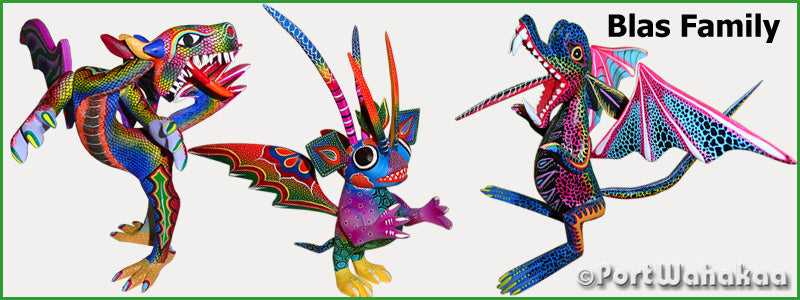
Famous Oaxacan Artist Margarito Melchor Copal Tree Master Mexico
See our new page dedicated to longtime legendary Oaxacan original Margarito Melchor. A magical artist that is easily one of the supporting columns of the art.
Go for The Original Cacao Has More Health Benefits than conventional Chocolate
A great article from Cacao news. Although chocolate is derived from the Cacao bean the latter offers a plethora of healthy perks and benefits. Improving mood and enhancing brain function name just two. We actually have come to appreciate what it does to prevent aging and fighting stress.
Port Wahakaa imports it's own brand of delicious all roasted 100% cacao chocolate bars in very limited quantities. They are nothing like American or European chocolate that is why we think you'll be delightfully surprised!
Tribus Mixes Studio Workshop Oaxacan Woodcarving Artistry Mexican Treasures in the City
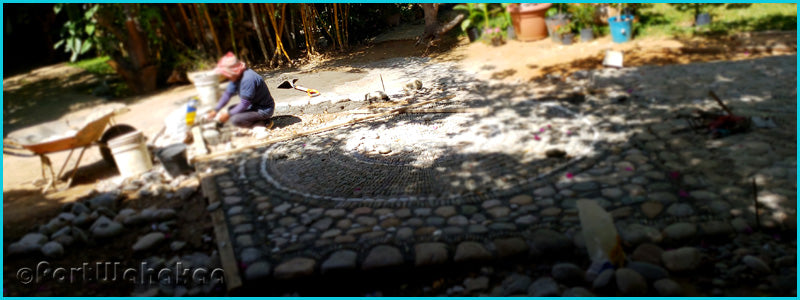
We were fortunate enough to pay a visit to the workshop of the most independent group of Oaxacan wood carvers the ones who call themselves Tribus Mixes. One of the only carvers found in the city of Oaxaca. Their styles have often been imitated but their methods of magic defy approach.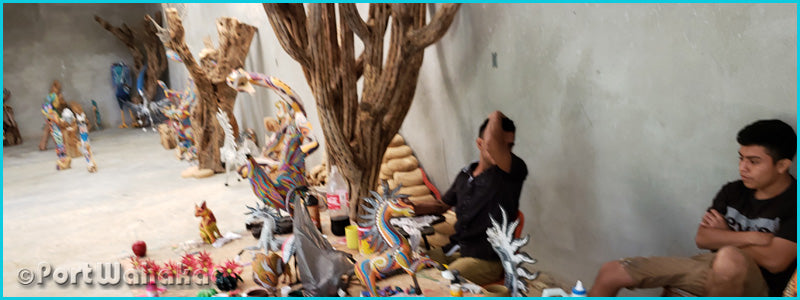
What first impresses is the stark difference between the exterior and interior of their workspace. The outside is nondescript and small in appearance but once inside opens up into large interior stone tiled cactus gardens, showrooms for larger works, and areas specific to carving or painting.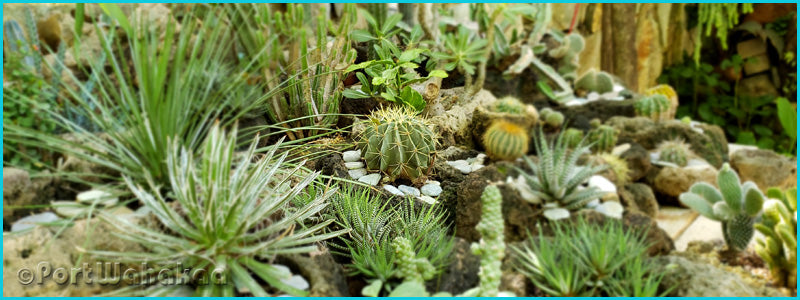
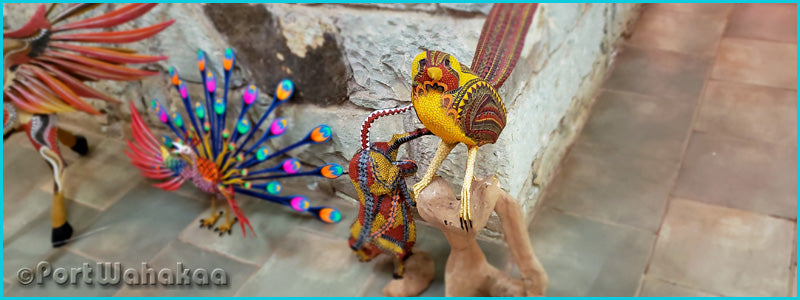
Our earliest memories of Tribus Mixes artists were in some of the juried shows back in the 1990’s. Nobody from the other villages used their materials or made dragons, cats, or insects anything quite like them. They had the purest observations of nature that they projected into their pieces and it’s even more extravagant in 2019. 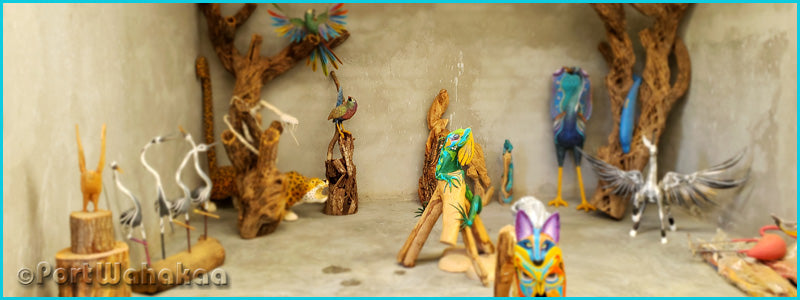
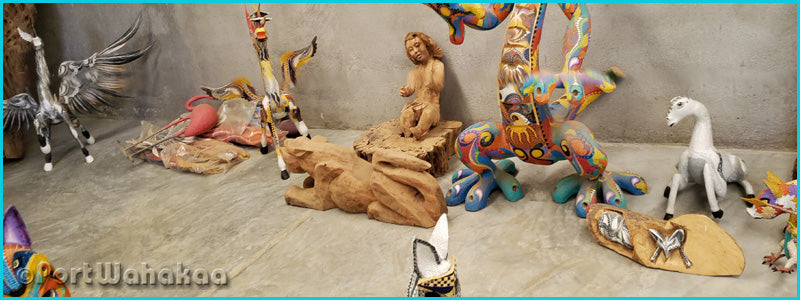
Although they prefer larger than life pieces they send to other destinations of Mexico and beyond they do a brilliant job in pieces under a foot long. Some of their natural woods are so beautiful they are reluctant to paint them. They use a variety of unusual woods such as encino, willow, ocote, cedrillos, and aguacatillos.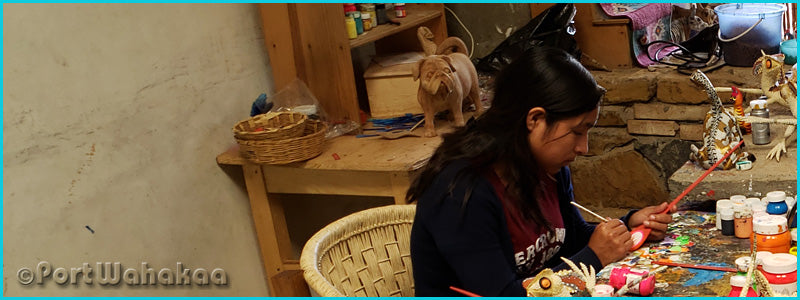
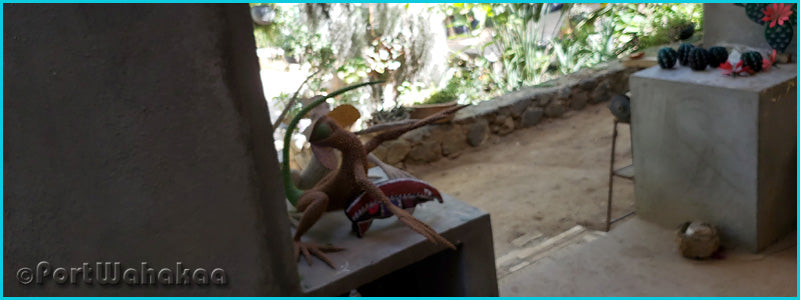
It’s easy to lose track of time when looking at their tremendous array of subjects. Wondering what unpainted or unassembled pieces will eventually morph into. Some painters of Mixes love complex colors while others prefer almost monotone. They cater to tastes beyond the scope of what popular artists villages have focused on over the last few decades. We were most dazzled with their birds and how they look real on tree branches. Who knows what supernatural creatures they will transform into on our next visit to the studio.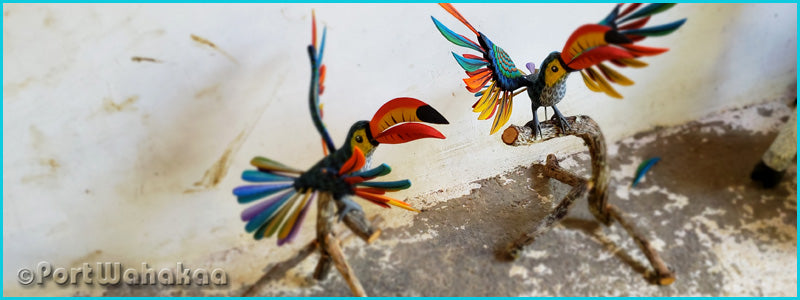
Coco Brings Alebrijes to the Big Screen in Epic Fashion
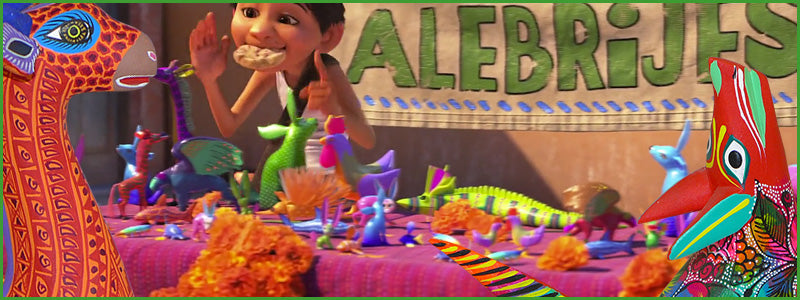
Coco is an endearing story we’ve recently enjoyed that features a subject near and dear to us ‘Alebrijes’. Innocently featured in the start of the movie they are displayed as you would see them at a market similar to Ocotlán de Morelos or at the entrance to Arrazola. Familiar Giraffes, Rabbits, Roosters, Lizards, and Fish can be seen on the table. In a tourist tienda the term Alebrijes or Alebriges would be used to describe the carvings. In an individual artist studio Animalito would be used if animals are their specialty. If you were to do an Alta Vista search in the 1990’s for Alebrije you would get links to Star Wars websites in Spanish. But we digress let us get back to the story.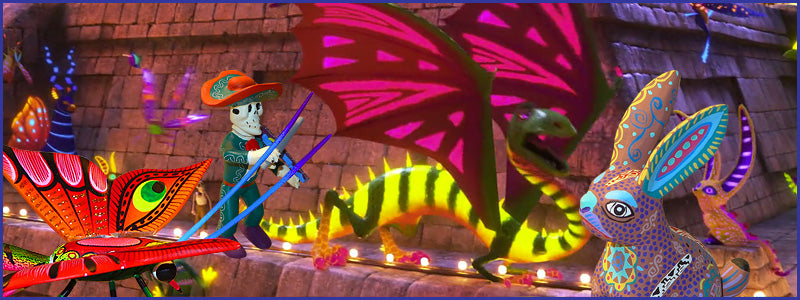
The really neat thing that happens in Pixar fashion is when our protagonist goes to the underworld in Beetlejuice style the Alebrijes become animated alive. Described by one of the denizens as ‘spirit guardians’ these creatures act as guides or messengers between the living and the dead. This harkens back to the Popol Val or Zapotec folklore describing certain animals like owls that have that ability. Once in the underworld Mayans describe large rivers to cross that only the resident dogs on the shore may ferry you across. It’s fascinating how the movie and Mexican folktales we’ve heard for 25+ years blend together.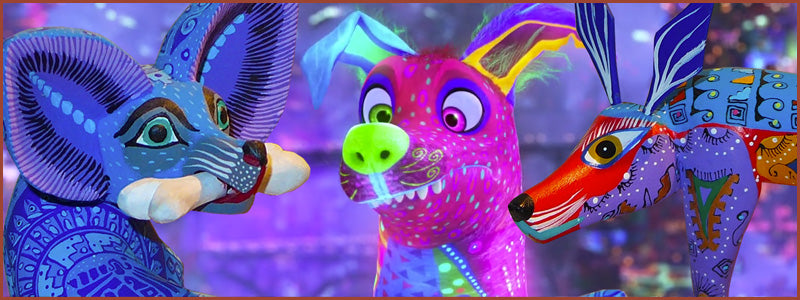
Ultimately the story is about creating an understanding for how Mexican cultures celebrate lost loved ones once a year. If it were a uniquely Oaxacan tale you couldn’t leave out the animal shape changer nahuals of San Martin Tilcajete and their amazing ability to play instruments. Alongside the skeletons would be a large population of red devils as they often outnumber skeletons in villages like La Union. It’s almost impossible not to shed a tear at the end but all in all a happy movie. A movie we wouldn’t mention had it not featured our decade after decade spanning endearing friends the Alebrijes. We haven't cried in a movie for ages. Fun for all ages. Oh yeah, and many of the carvings are found in our hundreds of different Alebrijes, Animalitos, Festivos, and Nahuals spanning the villages of San Antonio Arrazola, San Martin Tilcajete, La Union Tejalapan, San Pedro Cajonos, Ocotlán de Morelos, San Pedro Taviche, and Oaxaca City.
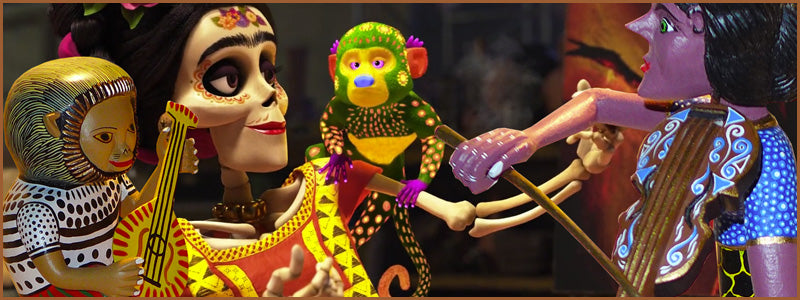
Day of the Dead Celebrated throuth the Magic in the Trees OaxacanWoodcarving
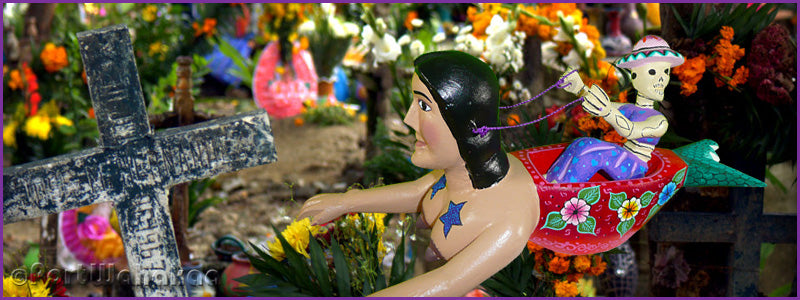
Dia de los Muertos is when the spirits come back to visit their families. Every house, store, cemetery, and zocalo have an alter to welcome back their loved ones. These temporary shrines contain a photo of the person, favorite drinks and food, mezcal, and keepsakes the dead may miss like left behind paraphernalia .

Copal incense and candles elevate prayers of the living. It is very important to build an alter for a specific person otherwise you could invite back a bad or lost soul or possibly devils. 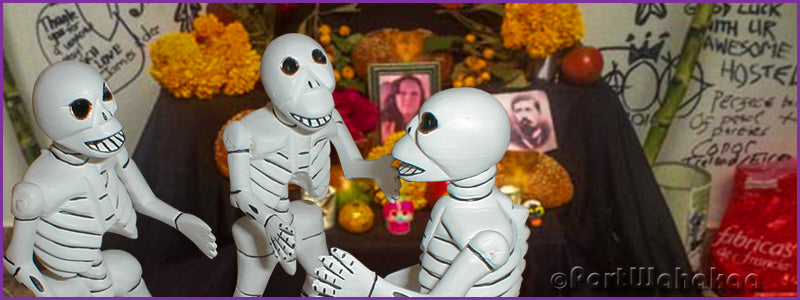
Days of the Dead are on November 1 and 2, however in Oaxaca lot of the festivities begin a week in advance. Parades on various streets meet in the zocalo, performers, vendors, clowns, and costumed kids and adults. On Halloween day the downtown cemetery in old downtown becomes the nexus of activities.
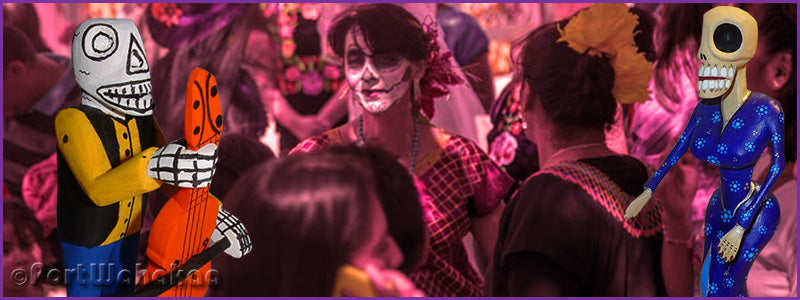
There you will see amazing costumes and artfully painted faces. Candles light the way. Tombs of loved ones graves are festooned with decorations and food. Here food is served and people dine around the graves celebrating.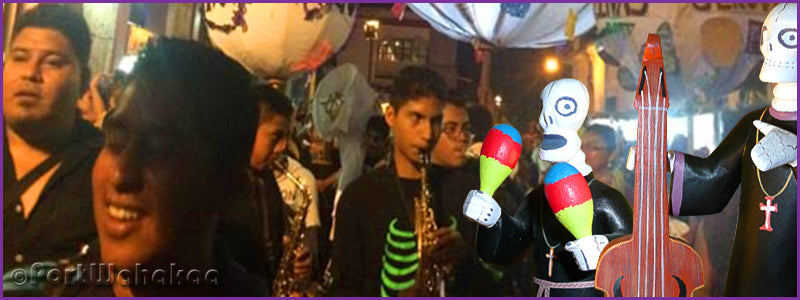
Day of the Dead is by far the biggest event of the year in Oaxaca. The character creations and inventions inspire everyone. From kids smeared in motor oil looking like devils to beautiful women in formal wear faces painted as skeletons.

Most of all it's a time for families to remember, acknowledge and appreciate the lineage of those that lived before them or the recently near and dear.
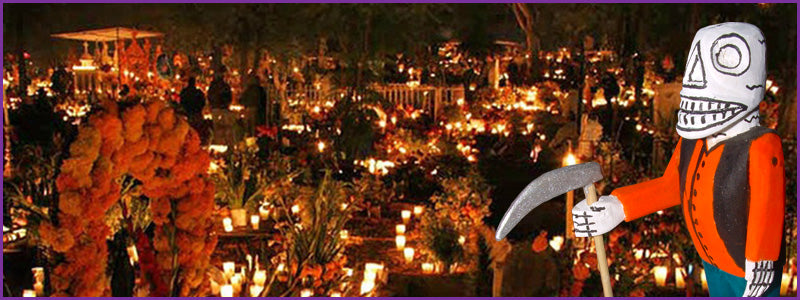
In the 21st century the concept are being mainstreamed into movies giving the world a glimpse of elaborate fashion and purpose.
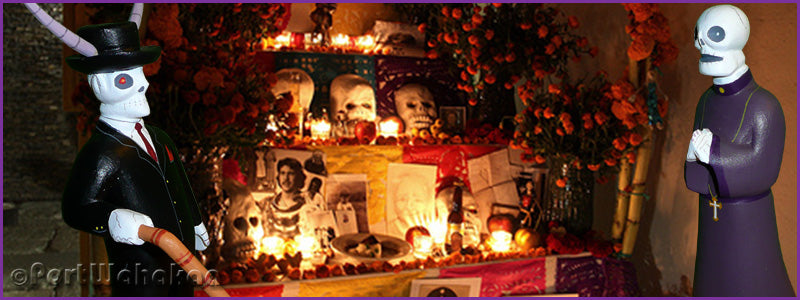
Oaxacan carvers produce very special themed pieces only at this time of year and we as collectors prize those uniquely one of a kind skeletons, devils, and nahuals for their thematic connection to the world beyond sight.
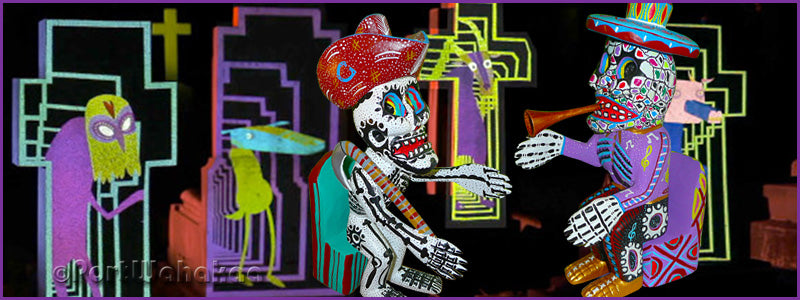
Guelaguetza reigns in Oaxaca Mexico Summer Dance Events Arena Expo
The Gift of Corn was a gift meant to keep on giving.
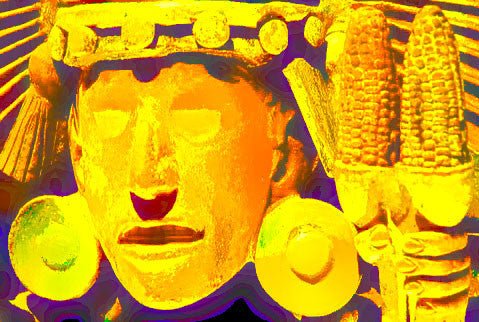
On the two Mondays that Guelaguetza reigns in Oaxaca. The time honored celebration of the corn goddess, Centeotl and the feast of Corpus Christi. A fusion of traditional and Spanish cuisines. Featured in the parade is the woman who represents the deity in the life and death of a Zapotec princess and the cult of the Virgin Del Carmen.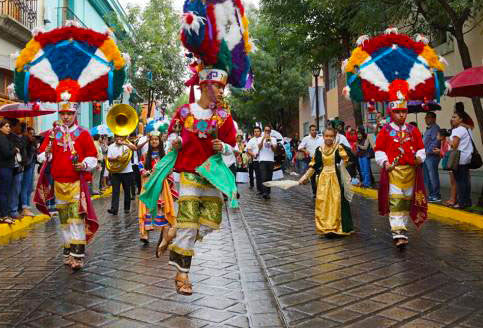
The inner colonial city hosts the festival to honor pre-Hispanic cultures. To Mexico, Oaxaca is the hub where the largest native indigenous population exists in tact. Between 50-60% of the residents have strong ties to the major Zapotec and Mixtec culture. Unique languages, gods, textiles, food and more characterize a uniquely ancient culture. In addition there are Oaxacan Chinese and Fisherman from Union Hildago who offer up song, syrup, and their own traditional garb.
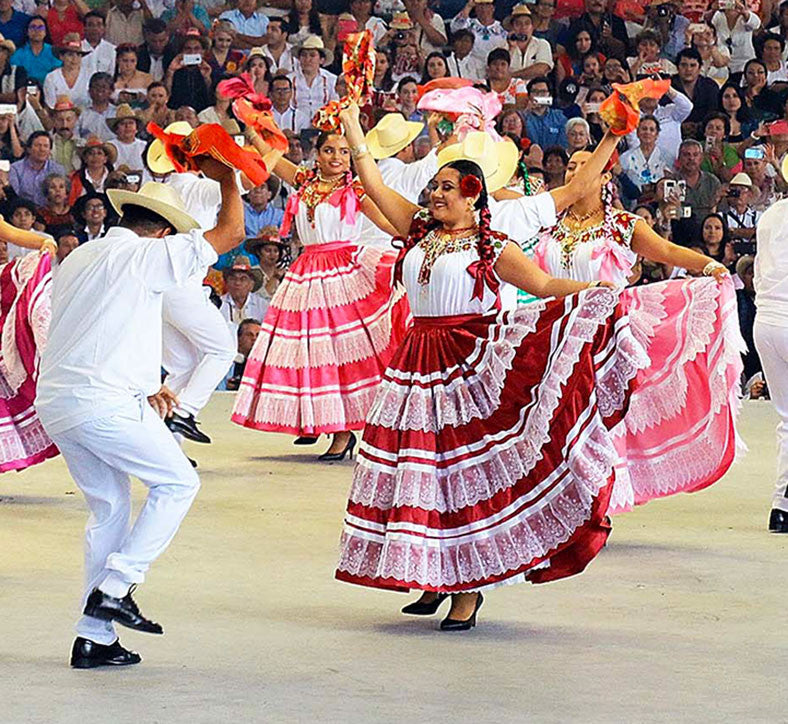
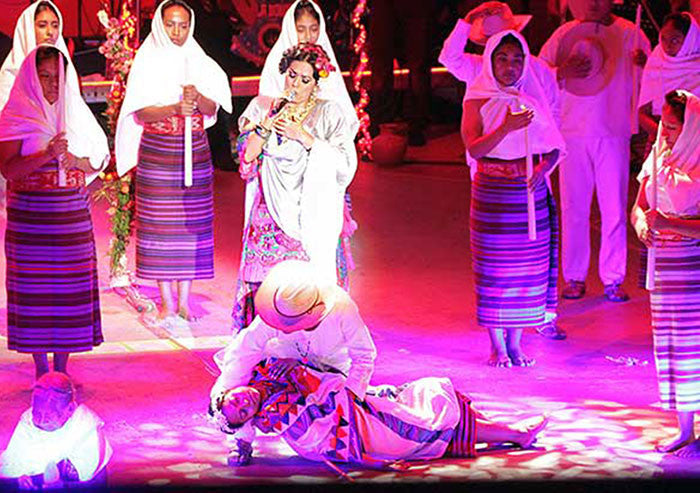
At the main event are seven groups representing seven regions of the state performing samples of their dancing in a large arena amphitheater. Seat holders cheer along to lively dancers and vocalists. In recent years sports competitions, theater performances, and artistic exhibitions are found throughout the city. Weather in July is some of the very best in Oaxaca. The air is very clean after the rains and everything is very green. One of the best times to visit.

Oaxacan Folklore Nahuals Toltec Travelers Mexican Magic Users Spirit Walkers
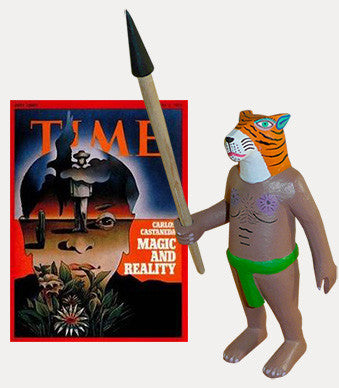
Many native Mexican folktale recount the antics of the Nahual, a strange shamanic sorcerer-type witch residing at the fringes of village life who prefer to operate where there are few to witness their craft. These beings have the ability to morph into animals and travel into the spiritual realm. Sometimes called naguals this name variation denotes a divine animal spirit within the individual. Divinity is usually depicted with feathered wings.

First recorded by Friars and Priests living in Mexico in the 17th century they were described as having the ability to change their shape to dogs, owls, armadillos, cows, chickens and most impressively jaguars.
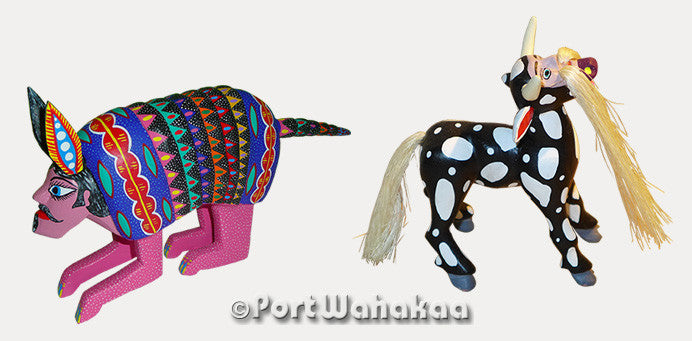
Toltec in origin these beings still exist today creating mischief to some and acting as guardians on others. Both feared and respected, it is said their ability to transform is directly related to the animal represented on it’s birth day. This spirit companion transformer has been adopted into movies like Ron Howard’s Willow, rock group Yes’s ‘Owner of a Lonely Hearts’ music video, and even Power Rangers. In ancient Persia and in mentioned in the Koran the Djinn were also able to shape shift. Comparisons can also be made to the wolf man of Europe.

In Oaxaca, the mestizo (Europe and American Indian) populations consider nahuals to have malevolent intentions while the Zapotecs and Mixes revere them as protectors of the people. The character of Don Juan in the Carlos Castaneda books was a type of shamanic practitioner nahuatl descendant who encouraged the main character to identify with animals and learn from their spiritual teachings.
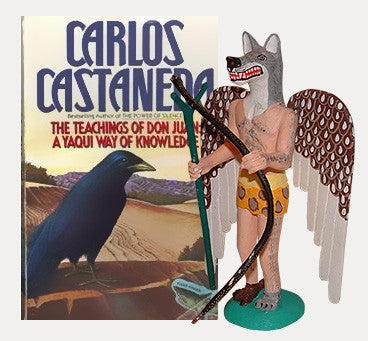
The three villages of Arrazola, San Martin, and La Union celebrate the subject of the nahual in many of their artisan works. Fanciful tales of stones transforming into people for the purpose of dancing and then shape shift into chickens. Music played for festival celebrations often depict people playing a musical instruments with such fervor that they morph into animals is a reoccurring theme.

Now relegated to simple trickery in order to get a free meal. The late Manuel Jimenez claims to have been challenged to strange contests of skill by several witches. It is often thought that the nahuals change their shape to farm animals in order to get a free meal. Woodcarvings of burros or cows are based around that folktale. As a rule of thumb nahuals usually have beards and blue eyes. Qualities that were very rare with those sharing Meso American ancestry.
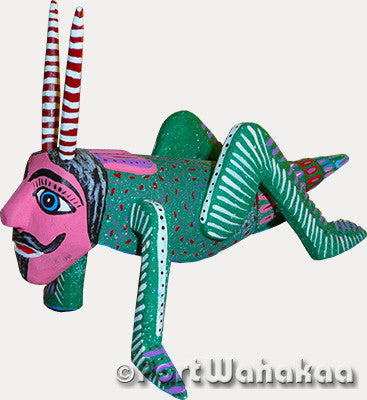
Famous Oaxacan Artists Edilberto Felipe & Mauricio Ramirez Mexico
The year opens with the arrivals of pieces by Edilberto Cortez and the artist team of Felipe and Mauricio Ramirez. When we first discovered these artists back in the early 1990s, we were amazed at their distinctive qualities that sets their work apart in the highly competitive Oaxacan village of Arrazola.
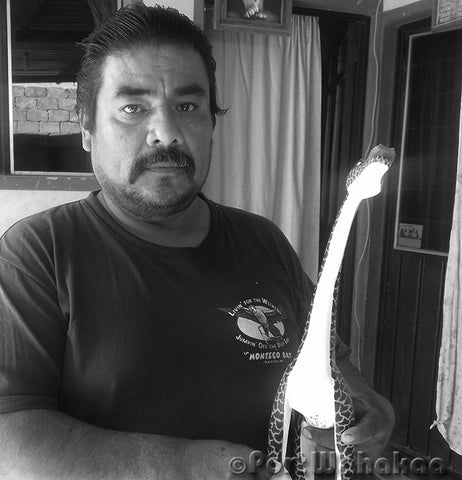
The eyes will immediately capture your attention when admiring a Oaxacan woodcarving and this is the magic in Edilberto's art. He has a unique way of creating 3D chiseled eyes on all of his works.

Starting with his Egyptian cats and working their way across his zoomorphic portfolio are animal eyes interrelated by the characteristic raised eye shapes. 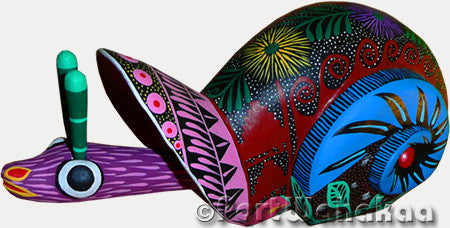 While other artists mimic Zapotec and Navaho patterns Cortez invents his own geometrical spaces and rules of color. An anteater will always portray the characteristics of an anteater while a snail will always have a lucid patchwork of prismatic positioning.
While other artists mimic Zapotec and Navaho patterns Cortez invents his own geometrical spaces and rules of color. An anteater will always portray the characteristics of an anteater while a snail will always have a lucid patchwork of prismatic positioning.
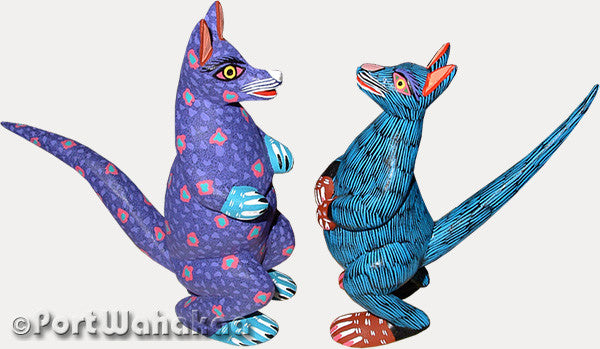
At the realistic end is his fur pattern painting style and splotchy patch method is entirely unique to him. Another feather in Edilberto's hat is the ability to evolve new styles while embracing his original hallmark designs.

Felipe and Mauricio Ramirez are the defacto Arrazola lizard painters. Over the years many artists have borrowed from their flaming multi-color camouflage with boundless color combinations.
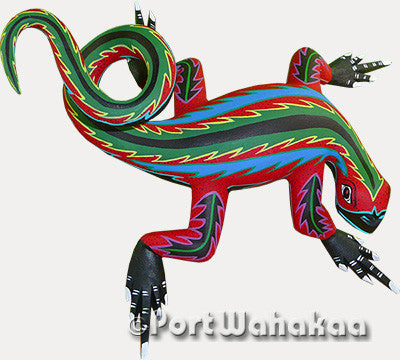
They are masters of mixing colors as they can make so many different hues work. The term 'no two are alike' quickly comes to mind when viewing the Ramirez brothers vast array of surreal swirling patterns and the contouring of multi-loop tailed lizards.
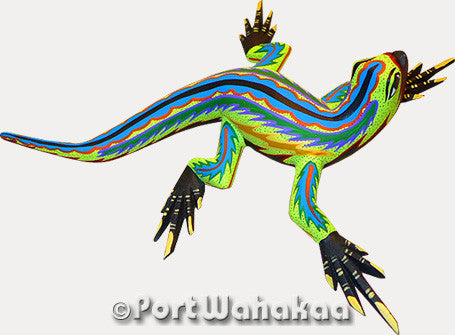
You could collect a hundred iguanas and two would never be alike. Their custom color palette has a higher degree of depth also sets them apart from other artists. In fact, colors that have only existed in Oaxacan pieces are ones Mauricio mixed himself.

Their pieces are often the only thing collectors collect forgoing the many other genres of village styles. Yes, 2017 has a magical start with these fantastic works new in the gallery.
Oaxacan Woodcarving: Historical Review
In 2017, our gallery hits the age of 21. The extent of artists and their works we've encountered reaches back into the early 1970s. In our own unconventional Port Wahakaa fashion we've illustrated the benchmarks as waves of creativity and invention. See it Here...
Oaxacan Hot Chocolate Frothy Style
The ultimate ancient Zapotec way to make cacao hot chocolate for the 21st Century
Stroll through San Martin
One of the most expansive of all the carving villages and arguably the oldest. They say it was San Martin that supplied the corn to the builders of Monte Alban. Visit at high noon and you will be able to spread out your walking legs as many will be indoors due to the suns intensity.

An agricultural base that either gets too much water or too little. These days people are more conscientious about how the water is managed.

Bougainvilleas line a maze work of streets and small bridges. Many people tend their own gardens. The heat is intense at mid day keeping most folks indoors.

From time to time you will see the workshop tiendas open for business with a lizard or painted cactus adorning the entrance to metal doors and brightly painted walls with murals. Or not entirely finished buildings of concrete with temporary doors.

While many of the artists are friendly the one of the most amicable and personable is Innocencio Vasquez. His festival diablos positioned in chairs and nahuals have been his mainstay for several decades. To him they are depictions of real supernatural creatures seen infrequently. He’s a wealth of information on these subjects of shape changers. His pieces tell a story part about the invisible world around us.


As we mentioned before San Martin has no shortage of perros and as you roam about town you will surely walk into their turf. Here is a puppy we encountered that just wanted to say hello.

From time to time you will see the workshop tiendas open for business with a lizard or painted cactus adorning the entrance to metal doors and brightly painted walls with murals. Or not entirely finished buildings of concrete with temporary doors.

Two of the greatest painters Roberta Angeles (Left) and Maria Jimenez (Right) are the masters of the floral patterns. While they like to tout their larger works it’s actually the smaller pieces that show off their uniquely individual pattern woven styles. These two have inspired three generations of Oaxacan carving artists working around them.

Back in 2004 we were lucky to run into Isidoro Cruz who was very engaging at the time, full of humor and spirit. He is one of the very last to use the aniline dyes which were the predecessor of Acrylic painted works. His stories of witches, nahuals, devils, and angels seen in the area over the years is expansive. He’s a legend of his village on par with Manuel Jimenez of Arrazola and Gabino Reyes of La Union.

Deep Deep Chocolate

Today! What a delight when a new batch of Oaxacabars arrive at Port Wahakaa. This time of year the Oaxacan chocolates are intensely potent with a deep dark intensity. Two bars would satiate any chocolate lovers for real chocolate. Great for Gifts! Nothing beats real Cacao (Milk Free) Chocolate!
25 Chocolates are 11.25 Quarter Sheet
50 Chocolates are 22.00 Half Sheet
100 Chocolate are 30.00 Full Sheet
Protests in Oaxaca make it difficult for the Artists
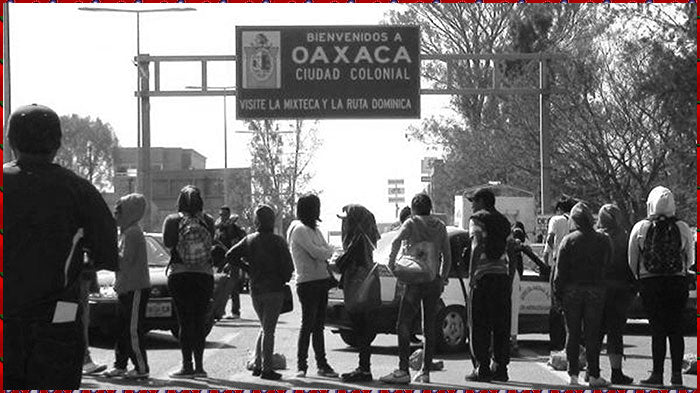
While the Teachers close down many roads and make their tent city base camp in Oaxaca’s Zocalo it is the artisans that are often the ones stuck in the middle of it all. Unable to get their wares to market and if they can the tourists are not there.

Some time around 2006 the Oaxaca National Coordinator of Education Workers or the 'Teachers' started coordinating large strikes and in recently have made permanent blockades of roads shutting down all kinds of commerce. While their motives and struggle are apparent it’s the citizens who depend on tourism to sell their crafts are having an incredibly difficult time making ends meet as the protests go on year after year.
Navigating the city center is like moving around under tarps and shops that have gone out of business. Trip Advisor has many comments regarding this on their site about the Zocalo being gloomy and intimidating. U.S Department of State has updated their Mexico Travel Warning in January 2016 stating that foreigners are routinely held up at knifepoint and robbed in many areas of Oaxaca. But does that stop us from getting collectors the best Oaxacan woodcarvings we can obtain at the same prices they were in 1998? Most certainly not. We blend in by dressing badly and walking quickly with purpose. The people of Oaxaca are resilient and have a sense of polite stoicism. Unfortunately, the protests have brought in many out of state elements that debase the essence of kindness and courtesy.
Before 2006 the Zocalo resembled
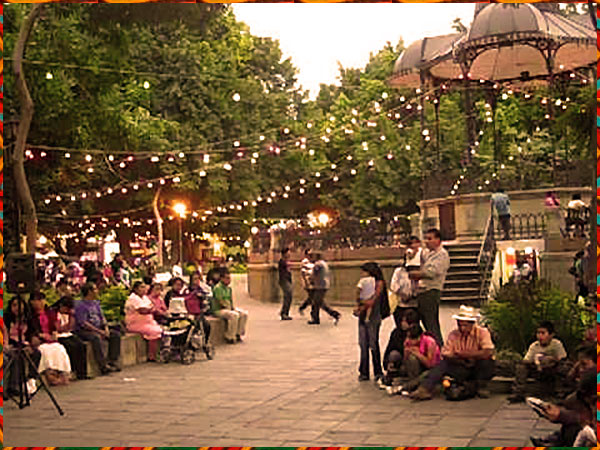
And these days resembles this
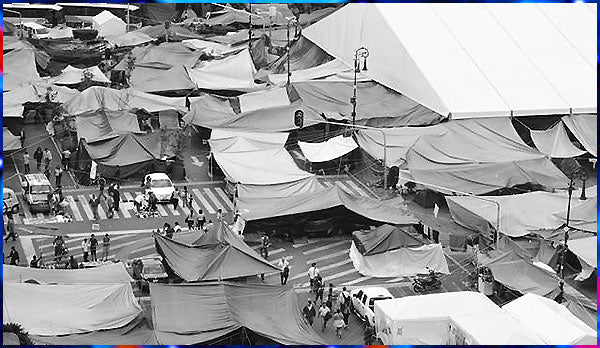
After ten years of dealing with these issues we thought it was time to let our collectors know the chaos that has made bringing Oaxacan Art to our gallery all the more difficult. Shipments get delayed for months and some carving villages like La Union are on roads that are often times closed due to protests. This has often times led to scarcity in the last two years. Still we have an amazing selection of works to chose from and continue to make the effort to logistically get pieces no matter how many times we may fall on our faces.
The LA times did a great article on this years Guelaguetza being mostly a bust for indigenous artisans who rely on the festival to sell their wares. This article from September 6 2016 indicates the protests are intensifying with no end in sight.
While we have always strictly focused on the Oaxacan woodcarving artists we feel it is time to mention that their world around them is seeing hard times. Makes you appreciate more than ever the work they do.
See the Sea Splendor
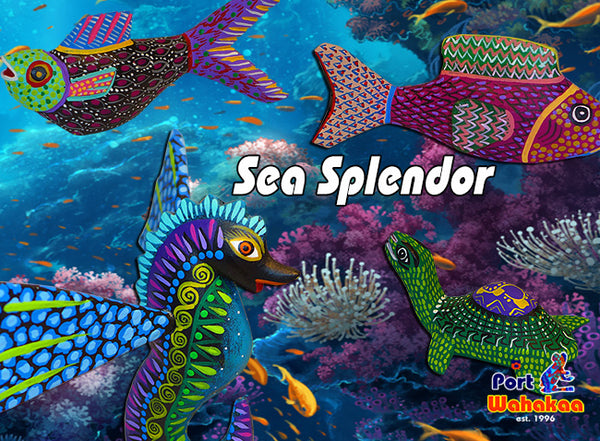
New pieces arrived this week from Arrazola. Amongst the splendid sea creatures are some impressive antelopes, jaguars, rams, and bulls. These will be highly appealing for the collectors who love the finely detailed fitting in the palm of the hand works.
Behemoth Beach Walkers
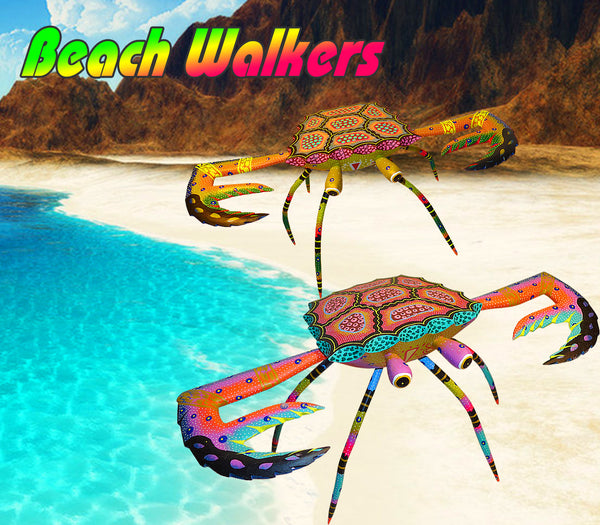
This summer walking in the from the sandy shoals are some of the largest most colorful crabs we've seen in over two decades. These towering alien looking jaibas of impressive stature comb the beach looking to socialize with other colorful decapods. Very intricate and a very sublime addition to a collection.
Dark chocolate good for the mind and body
Nottingham expert has found. A study led by Professor Ian Macdonald found that consumption of a cocoa drink rich in
flavanols a key ingredient of dark chocolate boosts blood flow to key areas of the brain for two to three hours.
Increased blood flow to these areas of the brain may help to increase performance in specific tasks and boost general
alertness over a short period.The findings, unveiled at one of the biggest scientific conferences in America, also raise the
prospect of ingredients in chocolate being used to treat vascular impairment, including dementia and strokes, and thus for
maintaining cardiovascular health.
The study also suggests that the cocoa flavanols found in chocolate could be useful in enhancing brain function for people
fighting fatigue, sleep deprivation, and even the effects of ageing.
400 Aztec Rabbits
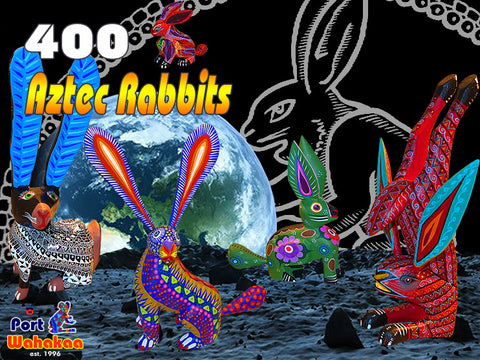
The artists of Oaxaca are deep rooted in Aztec mythology from the Popol Vuh . Every animal usually has a number of folk tales surrounding it's origins and clues to their perceived personality. For the western world Easter has some puzzling pagan ear markings (pun intended) of rabbits hiding brightly decorated Easter eggs.
In Aztec Mythology, the goddess Mayahuel rules both fertility and the maguey or agave plant. Along with the god Patecatl, she protects the maguey and its fermented sap, or pulque. One night, in a fit of passion, Patecatl and Mayahuel consummated their relationship and Mayahuel found herself pregnant.
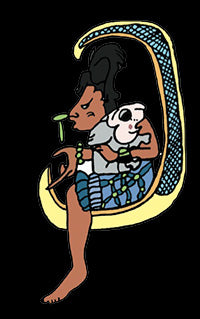
She gave birth to the Centzon Totochtin or 400 Rabbits, who were nurtured on pulque from her many breasts, and grew into the Gods of Drunkenness. These divine rabbits travel through the land, frequent parties and gatherings and deliver the gift of drunkenness to the people, with each Rabbit representing the different ways in which a person can experience intoxication.
Our Gallery has an amazing assortment of Rabbits (Conejos) simply do a search for the word: Rabbit
Fresh Chocolate Arrives

Today's fresh shipment of Oaxacabars were so incredibly fresh we could smell the chocolate through the box. Upon Sampling we were amazed at the powerful cinnamon that creeps up on you after that initial darkest of dark chocolate bite. These milk free bars are nothing but the pure power of chocolate cacao and immediately melt in your mouth.
Incredibly fair priced for chocolate of this high tier quality. Our chocolate comes from the same region the original purveyors of cacao 'the Aztecs' got theirs. Sourced from the southern rain forests of Oaxaca and the Chiapas.
Virtual Tour of Arrazola
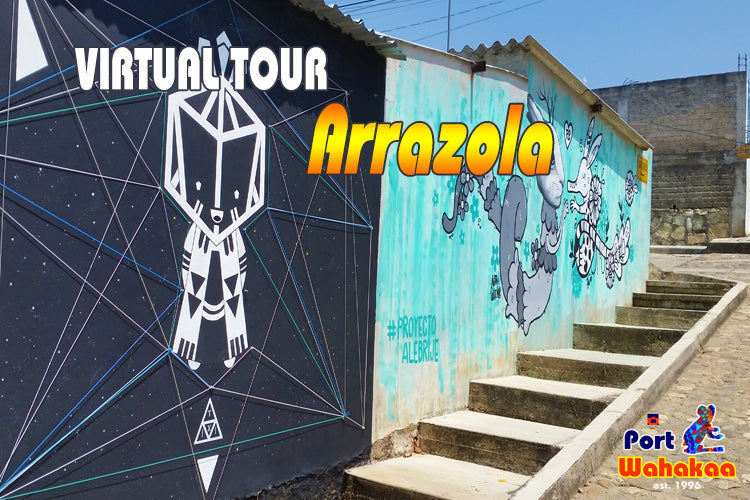
See the sights of the village situated beneath the ancient city of Monte Alban. A vivid tour of color along cobble stone streets and dust swept roads. Visit the artists on main street and the outer perimeter.
2016 Year of the Monkey Celebrated Through Oaxacan Artists Mexico Manuel Jimenez

We move into our 20th year of existence in the year of the Monkey. A mythic, symbolic and cosmological animal that is celebrated in the widest range of artist styles in Oaxacan Woodcarving. To see the par excellence pieces we have in the gallery simply type the word "monkey" in the search at the top left to see them.
![]()







